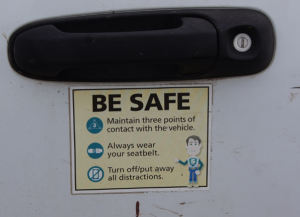 “Be Safe.” “Stay Alert.” “Drive Safely.” “Choose Safety.”
“Be Safe.” “Stay Alert.” “Drive Safely.” “Choose Safety.”
Safety slogans are abundant. Many are also abundantly unclear and ineffective.
The picture to the right is a sign on the door handle of a service truck. It provides an excellent example of why safety slogans are ineffective. Each slogan also demonstrates how product designs can be updated to include important systems, making safety slogans unnecessary.
First, this slogan does nothing to identify or eliminate hazards. The wording “maintain three points of contact with the vehicle” can be eliminated by incorporating near object detection devices into the vehicle during the design.
Second, the wording “always wear your seat belt” is not necessary if you have a system which has a constant buzzing noise or perhaps ignition interlock which prevents the vehicle from starting until the seat belt is engaged.
Third, the wording “turn off/put away all distractions” is not necessary if you have a system that blocks the phone signal (absent an emergency) while the vehicle is in operation. Perhaps this system would not be popular with consumers. However, humans have very poor divided attention abilities.
Fourth, if the poorly thought out slogan is to be used on this service truck, why is it on the outside by the door handle and not the inside to provide a constant reminder to the driver?
So, what does “be safe” really mean? This is the problem with poorly thought out slogans. The slogans are subject to various interpretations.
Safety is not common sense. What is common to you may not be common to another person. Safety, a science that identifies hazards, risks, and safety engineering alternatives, cannot be addressed by vague safety slogans. Safety begins long before a product or system reaches consumers.

